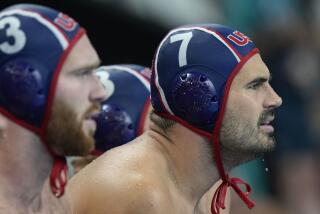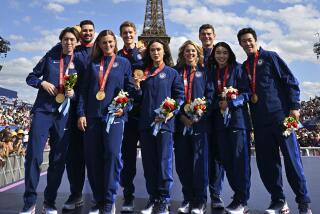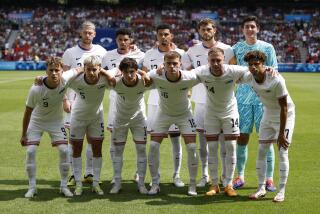Heart of U.S. hockey team have links to boyhood rinks

Long before they had heard of Sochi, well before they made it to the NHL, the five men who comprise the leadership group of the U.S. Olympic hockey team crossed paths many times on many rinks.
Fearless winger Dustin Brown grew up playing on B-level teams in small-town Ithaca, N.Y. He often competed against winger Ryan Callahan of Rochester, N.Y., a city big enough to have triple-A teams. One season, Callahan’s coach borrowed Brown to play in the famed Quebec peewee tournament. Brown and Callahan teamed up again on state teams and in juniors in Guelph, Canada.
Meanwhile, in Minneapolis, young center David Backes of the triple-A Minnesota Lightning was discovering the skills of Minnesota Blades winger Zach Parise. Those two, like Brown and Callahan, played with or against precocious defenseman Ryan Suter of Madison, Wis., at tournaments or camps.
Born within 10 months of each other in 1984 and ‘85, the five grew up to become respected leaders and were singled out to lead the Sochi squad before the roster was chosen.
“These are exceptional guys. It would be a better world if everybody were put together like these guys are,” said Dave Ogrean, executive director of USA Hockey.
“This is what I’ll call a third generation of American greats. The first one was very small, largely amateur, and really was the Miracle on Ice team. That team catalyzed the interest of a lot of guys in that Bill Guerin-Jeremy Roenick-Pat LaFontaine-Mike Modano-Chris Chelios generation, and I think they ended up being an inspiration to this group.”
Three are captains of their respective teams: Brown of the Kings, Callahan of the New York Rangers, and Backes of the St. Louis Blues. Parise and Suter are alternate captains of the Minnesota Wild, which signed each to a 13-year, $98-million free-agent contract in 2012. Before that, Parise was the captain of the New Jersey Devils.
Except for Parise, who’s sitting out because of an injured foot, they’re all bumping and bashing each other in NHL competition. “That’s something we went over this summer, that there’s going to be no love lost when we play against each other,” Backes said. “But when we get on that plane to go to Sochi we’ll get back to Team USA and the red, white and blue.”
Their mission will be difficult: to win the U.S. men’s first hockey gold medal outside the country. The previous men’s gold medals were won at Squaw Valley in 1960 and Lake Placid in 1980. But this team has a shot, thanks to an overall improved skill level and the commanding presence of its leaders.
“You can’t write stories like this. It’s fate or whatever. Someone has got a bigger plan,” Backes said. “It’s pretty amazing to think you played against a guy when you were 10 years old and now you’re teaming up with him 20 years later to go for Olympic gold. If you had a movie like that people wouldn’t believe it because it’s not realistic. Those are great storylines that hopefully we can put an exclamation mark on the end of.”
The five have represented the United States a combined 195 times at under-18, world junior, world, and Olympic championships. Suter leads with 64 appearances. All won silver medals at the 2010 Vancouver Games, where Brown, Suter and Parise were alternate captains. Brown also has a bronze medal from the 2004 world championships, and Suter and Parise won gold at under-18 and world junior tournaments.
Suter, the son of 1980 Olympic defenseman Bob Suter — whose No. 20 he wears — was drafted No. 7 in 2003 by Nashville. The Kings chose Brown 13th and the Devils took Parise 17th that year. Backes was a second-rounder in 2003 and Callahan was a fourth-round pick in 2004.
“It’s an impressive group,” Ogrean said. “And it’s having the presence of people like this not only on the roster, but willing to assume the mantle of being leaders on the team, that I think gives us optimism going forward in these Games in Sochi, when for whatever reason it seems as if the North Americans don’t do as well overseas as when we’re in the U.S. or Canada.”
Suter, who leads the NHL with an average of ice time of nearly 30 minutes per game, is modest about having been a lock for the roster and a leadership role.
“I was very fortunate to be on the team last time and be in that group last time and to be part of it again is a huge honor,” he said. “I really look forward to playing over there.”
Wild General Manager Chuck Fletcher said he spent big on Parise and Suter because he knew they were winners. Fletcher soon learned they’re driven to improve even though they’re financially set for life.
Watching practices before last season, Fletcher saw Parise unfailingly stay on the ice after every session to work on his shooting and stickhandling. At first, he was alone. Soon, Parise’s teammates followed his lead.
“What stands out for me is their professionalism, their preparation going into every game, how hard they practice, and how they take care of themselves off the ice,” Fletcher said of the duo. “It seems simple, but their work ethic is right at the top for any veteran players that I’ve seen.”
That trait, shared by every member of the leadership group, will be crucial to Team USA’s success in Sochi.
“The one thing all of us have in common is the way we play the game,” Brown said. “The four forwards are really hard on the puck. Parise is probably the best example. He might not be as physical as me, Cally, and Backes with the puck, but he’s like a bulldog with the puck. Suter is hard to play against in maybe a different way because he just thinks and skates the game so well. It’s hard to force him into mistakes.
“All of us are hard to play against, I would imagine.”
That was the idea behind designating them the heart of this team.
“That transition was in 2010, the changing of the guard,” Brown said. “Now it’s our group and guys that are maybe two, three, four years younger than us that are kind of the core guys on this team.”
Twitter: @helenenothelen
More to Read
Go beyond the scoreboard
Get the latest on L.A.'s teams in the daily Sports Report newsletter.
You may occasionally receive promotional content from the Los Angeles Times.







